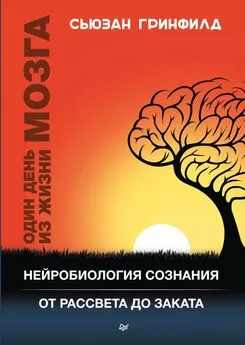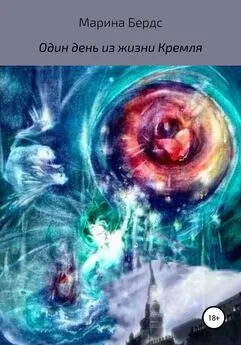Сьюзан Гринфилд - Один день из жизни мозга. Нейробиология сознания от рассвета до заката
- Название:Один день из жизни мозга. Нейробиология сознания от рассвета до заката
- Автор:
- Жанр:
- Издательство:Издательство Питер
- Год:2018
- Город:Санкт-Петербург
- ISBN:978-5-496-03109-7
- Рейтинг:
- Избранное:Добавить в избранное
-
Отзывы:
-
Ваша оценка:
Сьюзан Гринфилд - Один день из жизни мозга. Нейробиология сознания от рассвета до заката краткое содержание
В основе книги Сьюзан Гринфилд, прославленного британского ученого, писательницы и увлеченного популяризатора науки, многолетний опыт и недавние открытия в области нейробиологии, темпы развития которой поражают воображение. Гринфилд выстраивает настолько последовательный, подробный и образный рассказ о самом загадочном органе человеческого тела, что он становится практически осязаемым, а значит, понятным и запоминающимся.
Даже если это первая книга о мозге, которую вам довелось открыть, смело погружайтесь в новый парадоксальный мир. Уверяем вас, экскурсия будет приятной и содержательной.
Баронесса Сьюзан Гринфилд – кавалер ордена Британской империи, старший научный сотрудник Линкольн-колледжа Оксфордского университета, член Палаты лордов, обладатель 32 почетных степеней британских и иностранных университетов, а также многих наград, включая орден французского Почетного легиона и звание Почетного научного сотрудника Королевского колледжа врачей.
Один день из жизни мозга. Нейробиология сознания от рассвета до заката - читать онлайн бесплатно полную версию (весь текст целиком)
Интервал:
Закладка:
239
Gao, Wang&Goldman-Rakic, 2003.
240
Tsujimoto, 2008; см. также Welsh, М. С.&Pennington, В. F. 'Assessing frontal lobe functioning in children: views from developmental psychology. Developmental Neuropsychology, 4, 199–230 (1988).
241
Parsons et al., 2013.
242
Davis, С. et. al. 'Decision-making deficits and overeating: a risk model for obesity'. Obesity Research&Clinical Practice, 12, 929–35 (2004).
243
Tataranni, P. A.&DelParigi, A. 'Functional neuroimaging: a new generation of human brain studies in obesity research'. Obesity Reviews, 4, 229–38 (2003).
244
Tanabe, J. et al. 'Prefrontal cortex activity is reduced in gambling and nongambling substance users during decision-making'. Human Brain Mapping, 28, 1276–86(2007).
245
Cole, М. W. et al. 'Global connectivity of prefrontal cortex predicts cognitive control and intelligence'. Journal of Neuroscience, 32, 8988–99 (2012).
246
Greenfield, S. A. Mind Change: How Digital Technologies are Leaving Their Mark on Our Brains. (Random House, 2014).
247
Rosen, L D. et al. 'Media and technology use predicts ill-being among children, preteens and teenagers independent of the negative health impacts of exercise and eating habits'. Computers in Human Behavior, 35, 364–75 (2014).
248
Доказательства существования адаптационных изменений и их накопления уже задокументированы. В целом они приводят к более гибкой обработке информации, но в то же время меньшей рассудительности, сниженной эмпатии, повышению риска формирования нарциссического типа личности, нежелательной агрессии, параллельно отмечается повышение производительности при прохождении тестов IQ, улучшение рабочей памяти. Bavelier, D. et al. 'Brains on video games'. National Review of Neuroscience, 12, 763–8 (2011). Greenfield, S. A., 2014.
249
Коерр, М. J. et al. 'Evidence for striatal dopamine release during a video game'. Nature, 393, 266–8 (1998); см. также Weinstein, A. M. 'Computer and video game addiction – a comparison between game users and non-game users'. American Journal of Drug and Alcohol Abuse, 36, 268–76 (2010).
250
Greenfield, S. A., 2014.
251
Yuan, K. et al. 'Microstructure abnormalities in adolescents with internet addiction disorder'. PLoS One, 6, e20708 (2011).
252
This is a controversial and complex topic that is fully discussed in Greenfield, S. A., 2014.
253
Freis, Е. D.&Ari, R. 'Clinical and experimental effects of reserpine in patients with essential hypertension'. Annals of the New York Academy of Sciences, 59, 45–53 (1954).
254
Nutt, D. J. 'The role of dopamine and norepinephrine in depression and antidepressant treatment'. Journal of Clinical Psychiatry, 67 (suppl.6), 3–8 (2006).
255
Pletscher, A. 'The discovery of antidepressants: a winding path'. Experientia, 47, 4–8 (1991).
256
Healy, D. The Antidepressant Era. (Harvard University Press, 1997).
257
С тех пор, разумеется, было разработано множество фармацевтически сложных и селективных препаратов. Некоторые препараты предыдущего поколения провоцировали нежелательные побочные эффекты, такие как «сырный синдром» – ускорение сердечного ритма, повышение артериального давления, развитие гипертензивных кризов при одновременном применении антидепрессантов группы ингибиторов МАО с пищевыми продуктами, содержащими тирамин или его предшественник тирозин. Любой, кто их принимал, должен был избегать продуктов, богатых тирамином (сыр, шоколад и красное вино). В связи с этим был разработан новый класс препаратов – трициклические антидепрессанты, получивший свое название из-за особой химической структуры: они имеют три соединенных вместе кольца в молекуле, хотя структура этих колец и присоединенные к ним радикалы могут быть очень разными. Они значительно более избирательны, блокируют обратный захват (реаптейк) нейромедиаторов (преимущественно норадреналина и серотонина) пресинаптической мембраной. Эти препараты не влияют на метаболизм тирамина, поэтому пациенты, применяющие их, могут спокойно наслаждаться сыром и вином. Однако со временем антидепрессанты стали еще более селективными, и их эффективность значительно возросла с появлением третьего поколения препаратов, таких как Prozac.
258
Fitzgerald, P. J. 'Forbearance for fluoxetine: do monoaminergic antidepressants require a number of years to reach maximum therapeutic effect in humans? International Journal of Neuroscience, 124, 467–73 (2014).
259
Scott, J. 'Cognitive therapy'. British Journal of Psychiatry, 165, 126–30 (1994); см. также Cuijpers, P. et al. 'A meta-analysis of cognitive-behavioural therapy for adult depression, alone and in comparison with other treatments'. Canadian Journal of Psychiatry, 58, 376–85 (2013).
260
Anacker, C. Adult hippocampal neurogenesis in depression: behavioral implications and regulation by the stress system'. Current Topics in Behavioral Neurosciences (2014).
261
Sheline, Y. I. et al. 'Resting-state functional MRI in depression unmasks increased connectivity between networks via the dorsal nexus'. Proceedings of the National Academy of Sciences of the United States of America, 107, 11020–5 (2010).
262
Ren, J. et al. 'Repetitive transcranial magnetic stimulation versus electroconvulsive therapy for major depression: a systematic review and meta-analysis'. Progress in Neuropsychopharmacology&Biological Psychiatry, 51, 181 -9 (2014).
263
Yoshimura, R. et al. 'Comparison of lithium, aripiprazole and olanzapine as augmentation to paroxetine for inpatients with major depressive disorder'. Therapeutic Advances in Psychopharmacology, 4, 123–9 (2014). De Sousa, R. T. et al. 'Lithium increases nitric oxide levels in subjects with bipolar disorder during depressive episodes'. Journal of Psychiatric Research, 55, 96–100 (2014). Welsh, D. K.&Moore-Ede, M. С. 'Lithium lengthens circadian period in a diurnal primate, Saimiri sciureus'. Biological Psychiatry, 28, 117–26 (1990). Brown, K. M.&Tracy, D. K. 'Lithium: the pharmacodynamic actions of the amazing ion'. Therapeutic Advances in Psychopharmacology, 3, 163–76 (2013). Buigues, С et al. 'The relationship between depression and frailty syndrome: a systematic review'. Aging&Mental Health, 1–11 (16 Oct. 2014).
264
Yanagita, T. et al. 'Lithium inhibits function of voltage-dependent sodium channels and catecholamine secretion independent of glycogen synthase kinase-3 in adrenal chromaffin cells'. Neuropharmacology, 53, 881–9 (2007).
265
Mason, L. et al. 'Decision-making and trait impulsivity in bipolar disorder are associated with reduced prefrontal regulation of striatal reward valuation'. Brain, 137, 2346–55(2014).
266
Hercher, C., Chopra, V.&Beasley, С L. 'Evidence for morphological alterations in prefrontal white matter glia in schizophrenia and bipolar disorder'. Journal of Psychiatry and Neuroscience, 39, 130277 (2014).
267
Muzina, D. J.&Calabrese, J. R. 'Maintenance therapies in bipolar disorder: focus on randomized controlled trials'. Australian and New Zealand Journal of Psychiatry, 39, 652–61 (2005).
268
Lautenbacher, S.&Krieg, J. C. 'Pain perception in psychiatric disorders: a review of the literature'. Journal of Psychiatric Research, 28, 109–22 (1994); см. также Guieu, R., Samuelian, J. С&Coulouvrat, H. 'Objective evaluation of pain perception in patients with schizophrenia'. British Journal of Psychiatry, 164, 253–5 (1994); Dworkin, R. H. 'Pain insensitivity in schizophrenia: a neglected phenomenon and some implications'. Schizophrenia Bulletin, 20, 235–48 (1994).
269
Giles, L. L., Singh, M. K.&Nasrallah, H. A. 'Too much or too little pain: the dichotomy of pain sensitivity in psychotic versus other psychiatric disorders'. Current Psychosis and Therapeutics Reports, 4, 134–8 (2006).
270
Adler, G.&Gattaz, W. F. 'Pain perception threshold in major depression'. Biological Psychiatry, 34, 687–9 (1993).
271
Джаспер и Пенфилд обнаружил и, что удаление довольно больших участков коры (и разных областей) у пациентов с эпилепсией не влияет на способность испытывать боль. Penfield, W.&Jasper, Н. 'Epilepsy and the functional anatomy of the human brain'. (Little, Brown&Co., 1954).
272
Hall, К. R.&Stride, Е. The varying response to pain in psychiatric disorders: a study in abnormal psychology'. British Journal of Medical Psychology, 27, 48–60 (1954); см. также Pollmann, L.&Harris, P. H. 'Rhythmic changes in pain sensitivity in teeth'. International Journal of Chronobiology, 5, 459–64 (1978).
273
Koyama, T et al. 'The subjective experience of pain: where expectations become reality. Proceedings of the National Academy of Sciences of the United States of America, 102, 12950–5 (2005).
274
Ramachandran, V. S.&Blakeslee, S. Phantoms in the Brain: Probing the Mysteries of the Human Mind. (Harper Perennial, 1998).
Читать дальшеИнтервал:
Закладка:









